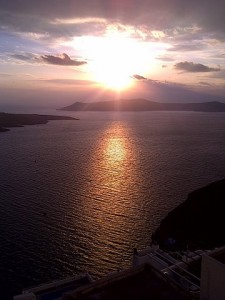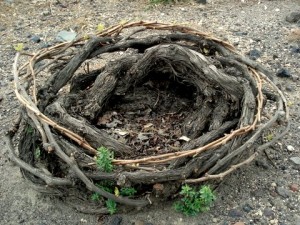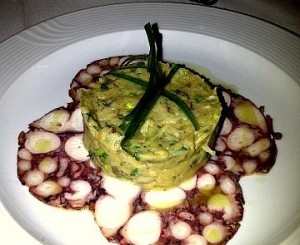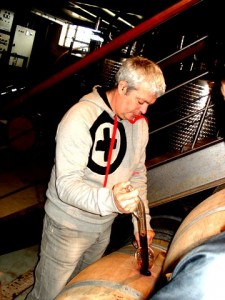Palate Press contributor Adam Caperton recently returned from a trip through Greece. Over the next three weeks we will feature his wine travels in pieces on Santorini, Peloponese, and Cephalonia.
Of the 220 islands that make up the Cyclades in the Aegean Sea southeast of mainland Greece, Santorini is a playground for jet setters, the wealthy and those who follow the seasons around the globe like dust on the wind.
Only two hours on the island after arrival and certainly not in the above class, I wasn’t getting the hype. Perhaps it was the jet lag and the 11am wine tasting in Athens before the second leg flight to the island? Possibly it was the rainy, cold and blustery day that greeted me on arrival?
Sure it was early April, but Santorini … sun … right?
After checking in and a stroll thru the winding streets of Fira, Santorini’s major city, I got my first glimpse of the volcanic caldera and my first glass of Assyrtiko wine, brisk and acidic, at a seaside café high on a cliff.
 With the dramatic sunset, I finally got it. That is, Santorini finally got a hold of me.
With the dramatic sunset, I finally got it. That is, Santorini finally got a hold of me.
Sitting there, it was hard to imagine the force of the Minoan volcanic eruption around 1600 BC, one of the largest in recorded human history. The caldera, the sea filled basin of the volcano, was formed when the eruption essentially blew the western half of the island off the map, covered the remaining with 60 feet of volcanic ash and debris and rained fiery death up to 150 kilometers away on Crete. History tells of a bad years farming as far away as China. Luckily, for today’s Santorinian winemakers, this disaster plus a pristine desert-like climate yields some of the most intriguing white wines on the planet and incomparable vin santo.
Though many grapes are native to this island, there are three main grapes used in Santorini’s white appellation—assyrtiko, aidani, and athiri—with assyrtiko comprising around 70 percent of total production. Vinsanto is, by law, made with all three varieties, using grapes raisinated in the sun for about ten days. Some wine producers use stainless steel while others prefer oak for fermentation and ageing.
Red wine production is becoming more common, mainly with the mandalariá and mavrotrágano grapes.
 A most intriguing aspect of the vineyards, which are based predominately on the eastern side of the island, is the training of the vines. The vines are coiled into basket shapes to protect the grapes. The grape bunches are grown on the inside to shield them from the harsh environment. All grapes are harvested by hand and yields are minimal. Some vines average upwards of 60 to 80 years old and since there has never been phylloxera, some rootstock is many hundreds of years old. As the vines lose vigor, they are lopped off at ground level, and a new shoot appears. Everything old is new again.
A most intriguing aspect of the vineyards, which are based predominately on the eastern side of the island, is the training of the vines. The vines are coiled into basket shapes to protect the grapes. The grape bunches are grown on the inside to shield them from the harsh environment. All grapes are harvested by hand and yields are minimal. Some vines average upwards of 60 to 80 years old and since there has never been phylloxera, some rootstock is many hundreds of years old. As the vines lose vigor, they are lopped off at ground level, and a new shoot appears. Everything old is new again.
For the wine geeks, Greek wine legislation is changing to reflect the new EU standards currently being implemented, the Protected Geographical Status (PGS). Sidestepping the old classification system are the new Protected Designation of Origin (PDO), Protected Geographical Indication (PDI), and Traditional Specialty Guaranteed (TSG). Anything else is a table wine. Santorini will fall into the PDO designation.
Wineries
There are many excellent wineries to visit, some more famous than others … Boutaris, Hatzidakis, Sigalis … Two also deserve special mention for their efforts. Gaía’s owner and winemaker is Yiannis Paraskevopoulos. Once lead winemaker at Boutaris, he is considered the wildman of Santorini. He is a mentor and teacher to many young Greek winemakers. His experimentation with native yeast and barrel fermentation/ageing is cutting edge and he is also looking to build the first microbrewery on Santorini at his seaside winery.
Estate Argyros is also a major player in bottlings of Assyrtiko and Aidani. Third generation owner and winemaker, Yiannis Argyros, is a man of few words and considered the leader on the island—that means the world—in the production of vinsanto. Remember to call ahead and arrange appointments at any wineries.
Restaurants
 Head off the beaten path and when you think you are safe, make a few more turns and explore. In Pyrgos, check out Selene for fine dining but I suggest you head down the steps to their cozy café and you will dine supreme under Slow Food Santorini’s founder and owner Mr. Hatzigiannakis’s watchful eye. Near Firostefani is Saltsa with a promising view the other way from the caldera. Chef Vasilis Zaharakis has Nichteri on Kamari Beach and Perivoli on the coastal road Exo Gonia. You could also of course do your own thing and hit the markets for amazing produce, capers, Santorini tomatoes, and seafood.
Head off the beaten path and when you think you are safe, make a few more turns and explore. In Pyrgos, check out Selene for fine dining but I suggest you head down the steps to their cozy café and you will dine supreme under Slow Food Santorini’s founder and owner Mr. Hatzigiannakis’s watchful eye. Near Firostefani is Saltsa with a promising view the other way from the caldera. Chef Vasilis Zaharakis has Nichteri on Kamari Beach and Perivoli on the coastal road Exo Gonia. You could also of course do your own thing and hit the markets for amazing produce, capers, Santorini tomatoes, and seafood.
Lodging
One can economize at the Costa Marina in Fira, which is well situated, clean, and offers free wifi. For the jet set, blow the bank and check out the Grace Santorini in Imerovigli. To experience the unique architecture of Santorini, look into a Yposkafo, or “cave house.” These are old houses built into the cliffs and renovated to give a sense of living life with the wind and sea.
Getting There
I heard a repeated phrase in Greece: GMT, or Greek Maybe Time. It pays to check schedules but flights from Athens and Thessaloniki leave daily to Santorini—more frequently in season. The Greeks know a thing or two about boats and their island ferry system is tops with an inexhaustible supply of delicious Greek Mythos beer on most vessels to pass the time. If you happen to have a helicopter, I noticed a few landing pads outside of some of the more swanky and exclusive resorts dotting the island. Just saying …
A photographic tour of Santorini
 Adam A. Caperton is a culinary, wine, and travel consultant and writer. He has been affiliated with The Viking Range Corporation and The Culinary Institute of America on their Viking Life / Worlds of Flavor travel program. A former chef, he lives in Richmond, VA with his wife Stephanie who works with Alton Brown of Food Networks Good Eats and Iron Chef America. Follow Adam on Twitter, @forknbottle
Adam A. Caperton is a culinary, wine, and travel consultant and writer. He has been affiliated with The Viking Range Corporation and The Culinary Institute of America on their Viking Life / Worlds of Flavor travel program. A former chef, he lives in Richmond, VA with his wife Stephanie who works with Alton Brown of Food Networks Good Eats and Iron Chef America. Follow Adam on Twitter, @forknbottle

